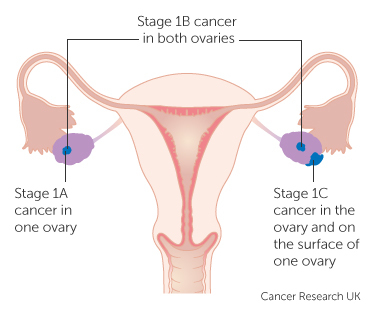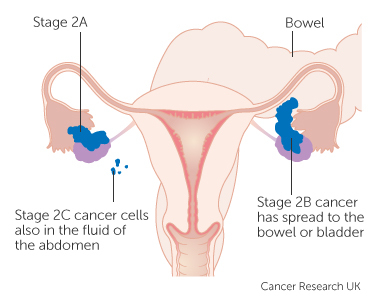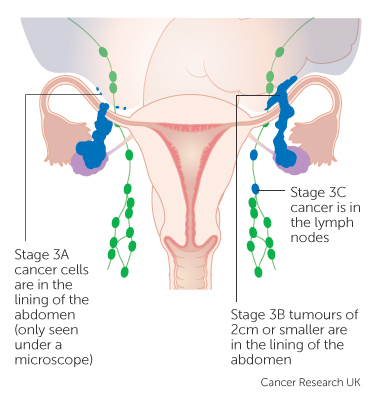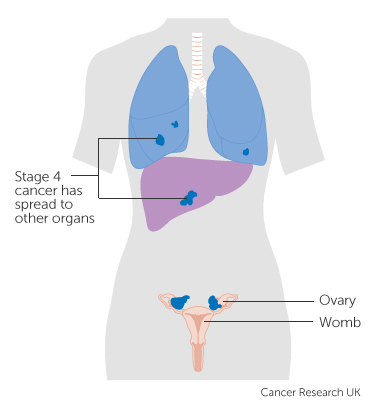Cancer of the ovary is the most common malignancy that affects the female reproductive system. It often develops undetected and spreads within the abdomen and pelvis, until it becomes difficult to treat. It is therefore frequently fatal. On the other hand, if detected early, it is more likely to be successfully treated. Hence, you may learn more about its staging to institute timely treatment such as surgery and chemotherapy.
Ovarian Cancer Staging
In the management of cancer, it is important to find out at diagnosis how widespread the cancer is. This is crucial because treatment and prognosis (outcome) may vary with the stage of the disease. The staging of the ovarian canceris often done during surgery because it is at this time when tissue samples can be obtained for laboratory examination and the surgeons can visualize the extent of spread of cancer cells in the abdomen or pelvis.
Stage I

In stage I ovarian cancer, malignant cells are found only within one or both ovaries. The fallopian tube/s may or may not be involved. In this stage, cancer cells have not spread to other abdominal organs, lymph nodes, tissues in the pelvis, or other distant sites. Further ovarian cancer stagingincludes classification into:
- Stage IA, where cancer cells are found inside one ovary or inside one fallopian tube, but no cancer found on the outer surfaces. Lab examination of abdominal and pelvic washings shows no cancer cells.
- Stage IB, where cancer cells are found in both of the ovaries/fallopian tubes, but none on the outer surfaces. Lab exam of abdominal and pelvic washings shows no cancer cells.
- Stage IC, where cancer cells are found in one or both ovaries/fallopian tubes and cancer cells are found on theouter surface of at least one ovary or fallopian tube or the capsule surrounding the tumor broke before or during surgery and cancer cells spilled into the abdomen/pelvis. Lab examination shows cancer cells in the fluid/washings from the patient’s abdomen.
Stage II

In Stage II Ovarian cancer, cancer cells are found in one or both ovaries/fallopian tubes and have spread to other abdominal/pelvic organs like the uterus, bladder, colon, or rectum. However, cancer has not spread to the lymph nodes or other distant sites. Further ovarian cancer staging includes classification into:
- Stage IIA, with either cancer starting in the ovaries and spreading to the fallopian tubes and/or uterus OR cancer from the fallopian tubes spreading to the ovaries and/or uterus.
- Stage IIB, with cancer growing into nearby pelvic organs like the bladder, colon, or rectum.
Stage III

In stage III ovarian cancer, cancer cells have spread to the lining of the patient’s abdomen and/or to the retroperitoneal lymph nodes (found at the back of the abdomen). Further ovarian cancer staging includes classification into:
- Stage IIIA1, with cancer in one or both ovaries/fallopian tubes, and affecting nearby pelvic organs and retroperitoneal lymph nodes
- Stage IIIA2, with cancer in one or both ovaries/fallopian tubes, and affecting nearby pelvic organs and retroperitoneal lymph nodes. In addition, tissue biopsies show that tiny foci of cancer cells are growing in the upper abdominal lining.
- Stage IIIB, where cancer is in one or both ovaries/fallopian tubes, and it has spread or grown into nearby pelvic organs. In addition, large foci of cancer are visible in the abdomen, including the liver, the spleen and the lymph nodes.
- Stage IIIC, where cancer is in one or both ovaries/fallopian tubes, has grown into nearby pelvic organs, and with much larger foci of cancer visible in the abdomen, including the liver, the spleen and the lymph nodes. However, cancer has not spread to the inside of the liver, spleen or to other distant sites.
Stage IV

Stage IV is the most advanced stage because cancer has grown into the inside of the liver, spleen, lungs, and other organs. Further ovarian cancer staging includes classification into:
- Stage IVA, where cancer cells have spread into the fluid surrounding the lungs (a condition called malignant pleural effusion).
- Stage IVB, where cancer cells have spread to other abdominal organs including the liver, spleen, lymph nodes, as well as the lungs, brain and skin.
Outlook of Ovarian Cancer by Stage
Ovarian cancer staging can also guide physicians and patients regarding the outcome of the disease:
Stage 1
Around 30% of women who are diagnosed with ovarian cancer are first seen at stage I of the disease. About 90% of these women will survive for at least 5 years after diagnosis, depending on the type of tumor and the patients’ general health.
Stage 2
Only 4% of women with ovarian cancer are first seen at stage II. About more than 40% of the patients will survive for at least 5 years after diagnosis.
Stage 3
Around 40% of women with ovarian cancer are first seen at stage III of the disease. Only 20% of these women will survive for at least 5 years after their diagnosis.
Stage 4
Approximately 15% of women with ovarian cancer are diagnosed at an advanced stage when first seen. And since the cancer has already spread to other organs, very few (5%) will survive for at least 5 years after their diagnosis.
These figures are just estimates based on statistical records. The prognosis of a cancer patient often varies with the type of tumor involved, the parts of the body affected, and the rate at which the cancer grows and spreads. It is important to emphasize that early diagnosis and treatment are necessary, because treatment may vary according to the ovarian cancer staging.
